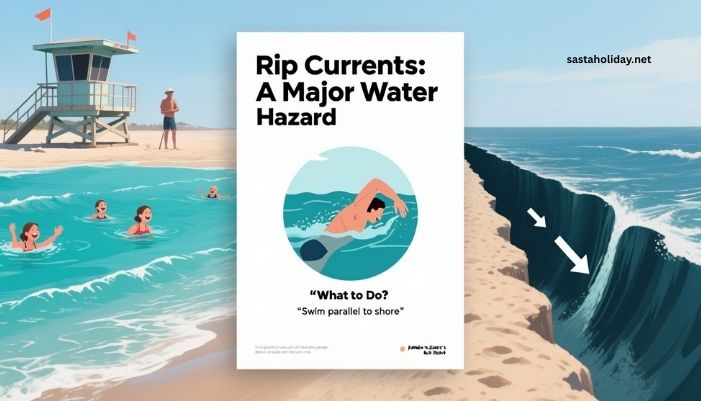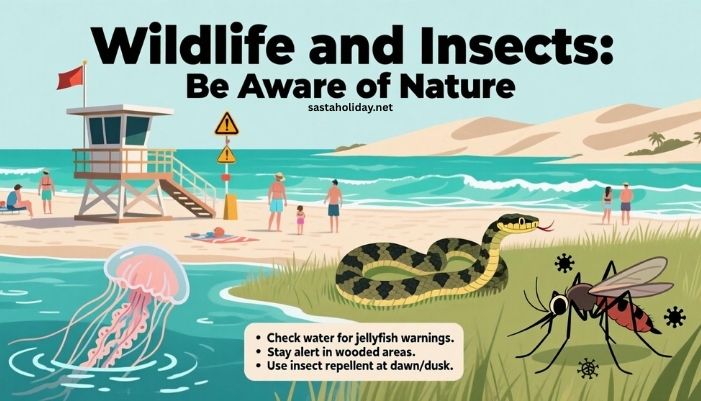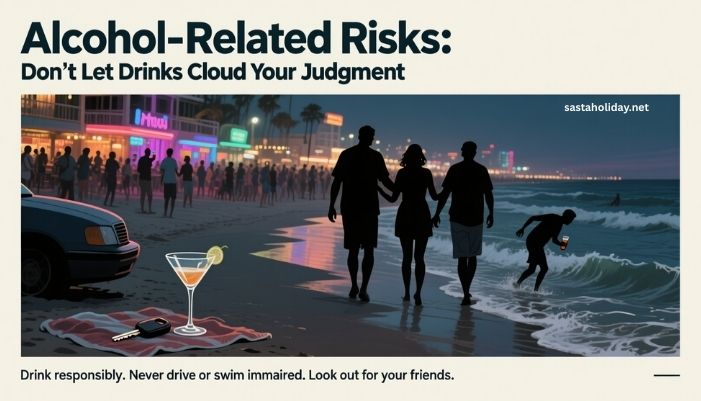Daytona Beach is a popular vacation spot, with its long stretches of sandy beaches, exciting events, and lively nightlife. It’s easy to see why so many people flock to this Florida destination. But beneath its sunny exterior, there are real dangers. Daytona Beach is known for several hazards that can quickly turn a fun trip into a dangerous experience.
In this article, we’ll go over why Daytona Beach is dangerous, covering everything from car accidents on the beach to dangerous swimming conditions. Plus, we’ll give you tips on how to stay safe.
Driving on the Beach: A Hidden Risk
One of the unique features of Daytona Beach is that it allows cars to drive directly on the sand. While this might seem like fun, it comes with significant risks.
The Danger: Driving on the beach can be tricky. Sand makes it harder for vehicles to grip the surface, especially near the water where the sand is wetter. Many drivers find themselves getting stuck or losing control of their cars. The tides can also come in quickly, trapping vehicles in water.
How to Stay Safe: If you choose to drive on the beach, make sure to stick to the designated areas. Drive slowly and avoid going too close to the water. Always be aware of the tides and never drive when they’re coming in. If you do get stuck, have a shovel or a tow rope to help get out.
Rip Currents: A Major Water Hazard

The beach’s warm waters and waves are perfect for swimming, but they also bring danger. Rip currents are strong, fast-moving currents that can pull swimmers far from the shore.
The Danger: Rip currents are hard to see, and many swimmers don’t realize they’re in danger until it’s too late. These currents can be powerful enough to carry someone away from the shore quickly. Panic often makes the situation worse, especially if people don’t know what to do.
How to Stay Safe: Always swim in areas where lifeguards are present and pay attention to any warning signs. If you find yourself caught in a rip current, don’t fight it. Swim parallel to the shore until you’re out of the current. If you’re not a strong swimmer, avoid swimming in rough waters.
Pedestrian Accidents: Risks from Heavy Traffic
Daytona Beach isn’t just crowded with beachgoers; it’s also full of cars, bikes, and tourists. With so many people walking around and cars driving by, accidents can happen.
The Danger: The high volume of traffic makes walking around the area risky. Pedestrians sometimes ignore traffic rules, leading to accidents. Many of these accidents happen when drivers don’t see pedestrians or when people walk in places where they shouldn’t.
How to Stay Safe: Always use crosswalks when walking on or near the road. Pay attention to traffic signals and make sure cars stop before crossing. If you’re walking at night, wear bright clothing to stay visible. Avoid walking in areas with heavy traffic unless there’s a sidewalk.
Wildlife and Insects: Be Aware of Nature

Daytona Beach is home to various wildlife, and some of it can be dangerous. You may come across venomous snakes, aggressive jellyfish, or even dangerous insects.
The Danger: Jellyfish stings are common at the beach, and some species can cause severe reactions. Snakes, like the Eastern Diamondback Rattlesnake, live in the area too, and their bites can be life-threatening. In addition, mosquitoes in the area can carry diseases like the West Nile Virus.
How to Stay Safe: Always check the water for jellyfish warnings before swimming. If you’re walking near grassy or wooded areas, be aware of your surroundings to avoid snakes. Wear insect repellent, especially at dusk and dawn when mosquitoes are most active.
Large Crowds: The Dangers of Overcrowding
Daytona Beach hosts major events like the Daytona 500 and Bike Week, attracting thousands of visitors. These large crowds can create dangerous situations.
The Danger: When large crowds gather, the risk of accidents increases. People may get hurt in stampedes, and it’s harder for emergency responders to reach people quickly. The noise and excitement of events also increase the chances of dangerous behavior, like reckless driving or fighting.
How to Stay Safe: If you’re at a crowded event, keep an eye on your surroundings. Make sure your personal belongings are secure, and know where the exits are in case of an emergency. It’s also helpful to have a plan for meeting up with friends if you get separated in the crowd.
Alcohol-Related Risks: Don’t Let Drinks Cloud Your Judgment

Daytona Beach’s nightlife is part of its appeal, but alcohol can also make things dangerous. People often drink before heading to the beach or when they’re out at bars, and alcohol impairs decision-making.
The Danger: When people drink, they tend to take more risks. Whether it’s swimming in dangerous conditions, driving under the influence, or getting involved in fights, alcohol can lead to bad decisions. In some cases, people even end up injured or lost because they’re too drunk to make good choices.
How to Stay Safe: If you plan to drink, do so in moderation. Never drive after drinking and never swim after consuming alcohol. Keep an eye on your friends, and make sure everyone gets back to your hotel or rental safely. It’s also a good idea to have a designated driver or take a taxi or rideshare to avoid the dangers of drunk driving.
Weather: Be Ready for Sudden Changes
Florida’s weather can be unpredictable, and Daytona Beach is no exception. While the area enjoys lots of sunshine, storms can appear out of nowhere, especially in the summer.
The Danger: Heavy rains, strong winds, and lightning can strike quickly. Lightning is a particular danger at the beach, where people are often the highest point on the shore. These storms can also cause dangerous surf conditions, making it risky to swim.
How to Stay Safe: Always check the weather forecast before heading out. If you see a storm coming, get off the beach and take shelter indoors. If you’re caught in a storm, stay away from tall structures and trees, and never stay in the water when there’s lightning. Pay attention to emergency alerts and evacuation orders if a hurricane is on the way.
Conclusion
Daytona Beach is a beautiful and exciting place to visit, but it comes with its own set of dangers. From driving on the beach to dangerous wildlife, rip currents, and even crowded events, there are many hazards to watch out for. However, with the right precautions, you can enjoy everything Daytona Beach has to offer while staying safe.
Whether you’re here for a day of sun, an exciting event, or just a relaxing vacation, always keep safety in mind. By being prepared and aware of the risks, you can make the most of your trip without putting yourself in danger.
FAQs
Q1: Is it safe to drive on Daytona Beach?
A1: It’s safe as long as you stay in designated areas and drive slowly. Avoid driving near the water and always watch for changing tides.
Q2: What should I do if I get caught in a rip current?
A2: Stay calm and swim parallel to the shore to escape the current. If you can’t make it back to shore, float on your back and signal for help.
Q3: Are there jellyfish at Daytona Beach?
A3: Yes, jellyfish are common in the waters. Be sure to check for warnings before swimming, and watch out for stings.
Q4: What’s the best time to visit Daytona Beach?
A4: The best times to visit are in the fall or early spring when there are fewer tourists, and big events like spring break or Bike Week aren’t taking place.
Q5: How can I avoid mosquito bites at Daytona Beach?
A5: Use insect repellent, especially in the early morning and evening when mosquitoes are most active. Try to avoid areas with standing water, where mosquitoes breed.


